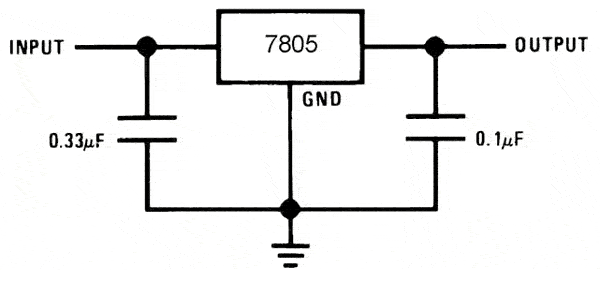Using a 7805 regulator - 12v to 5vhttp://forums.parallax.com/forums/posticons/i
I recently bought some 5" 7 segment displays on ebay which runs on 13v.
My questions is how do i connect a 7805 to run 13v to 5v. I seen some circuits with
two capacitors (one on IN and the other on OUT) and some had differnt capacitor values.
is circuit only fro AC only?
I was planning to us a power adapter @ 15v to power the 7segs and 7805 to convert down to the primary circuit .
Can some one point me in the right direction. Do use this circuit below?
My questions is how do i connect a 7805 to run 13v to 5v. I seen some circuits with
two capacitors (one on IN and the other on OUT) and some had differnt capacitor values.
is circuit only fro AC only?
I was planning to us a power adapter @ 15v to power the 7segs and 7805 to convert down to the primary circuit .
Can some one point me in the right direction. Do use this circuit below?




Comments
▔▔▔▔▔▔▔▔▔▔▔▔▔▔▔▔▔▔▔▔▔▔▔▔
- Stephen
What does the spec sheet says about MIN voltage of you display?
Are you using any kind of intensity control?
What is your +15V DC· supply· recommended / continuous / maximum· load (DC mA) ? .
·
·
Calculate your display minimal current (check the spec sheet again for current per segment) ·(least segments on / lowest intensity) than find a resistor value for 13V and your calculated current.
Plug the resitor to your DC power supply and quickly ( if you using small wattage test resitor) ·measure the actual voltage across.
If it is lower than MAX voltage of the display you are OK and use it directly to power the display.
·
If not get a· +12 V regulator rated for maximum display (all segments on maximum intensity ) ·and run you display from that. Use correctly rated (current) ·“ 7812” type.
You probably won’t notice any intensity difference than when run from 13 volts.
·
Words of caution – some older LED displays (“ebay style”[noparse];)[/noparse] may require relatively large current.
Do not connect your LED display to·output of 7805 running the processor! The Basic Stamp (BS2) "internal" regulator is rated for about 50 mA and has a tendecy to "let out the smoke" if overloaded!
Cheers
Vaclav
▔▔▔▔▔▔▔▔▔▔▔▔▔▔▔▔▔▔▔▔▔▔▔▔
· -- Carl, nn5i@arrl.net
If this is an automotive environment, there are newer linear regulators that work better in that situation. Parallax uses the LM2940-5 with good results.
Ideally, these 1 amp linear regulators are best operated at about 7.5VDC input to optimize performance. (I suspect 6VDC input is a wee bit too low.) And these days, there are switching regulators that might run cooler and conserve more power.
In any event, a lot of us started with the LM7805 and it is a pretty standard item.
13VDC is a bit odd.... sounds intended for automotive use. It may indicate the nominal full charge of an automotive lead acid battery (usually 13.8VDC). But those batteries in an automotive situation vary widely in voltage (often mentioned as 12VDC). When fully charged, the range can be higher (such at 14.5VDC).
So considering the possible range from 12VDC to 14.5VDC in an automotive situation, regulation is important.
The LM317 is an adjustable linear voltage regulator that can provide an exact 13VDC as long as the input is about 2 volts higher than the regulated output.
This actually has nothing to do with automotive power (which I digressed into mentioning above). Please forgive the distraction.
But you will need something higher in a linear regulator to get a good 13VDC.... about 15VDC or more